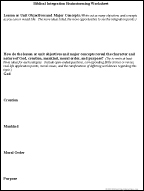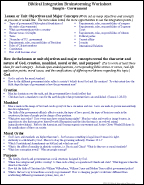Brainstorming: The Value of Planning Ahead
 Brainstorming ahead of time for any lesson is invaluable in many ways. Planning a biblically integrated unit is even more so. Not only does it provide an opportunity to think through a unit, but it also helps the teacher think about the unit from the bigger biblical perspective. The brainstorming worksheet was designed to help teachers plan a complete unit with integration points, discussion starters, Bible verses, real-life experiences and ramifications.
Brainstorming ahead of time for any lesson is invaluable in many ways. Planning a biblically integrated unit is even more so. Not only does it provide an opportunity to think through a unit, but it also helps the teacher think about the unit from the bigger biblical perspective. The brainstorming worksheet was designed to help teachers plan a complete unit with integration points, discussion starters, Bible verses, real-life experiences and ramifications.
How to Use the Brainstorming Worksheet
First, choose a unit of study. It’s best to start with an easy unit. A difficult one could be discouraging and frustrating, and take more time than one wants.
Second, write out the objectives and concepts that will be covered in the unit. The more ideas written down and the more detail, the easier it will be to think of integration points.Third, consider how the objectives and concepts reveal the character or nature of God, creation, mankind, moral order, or purpose. These can be written down as specific truths the students should learn, as open-ended discussion questions, ideas for the teacher to develop, real-life examples, worldview issues, and related Bible stories and references. Ideally there should be two to three integration ideas for each of the five categories; God, creation, mankind, moral order and purpose. Some ideas may fit into more than one category, but that’s ok. They can go in either one. It is better to have too many integration ideas than not enough.
Brainstorming Worksheet Sample
Finally, choose the integration ideas you intend to use in the classroom. Try to identify the specific truths you want your students to be able to articulate by the end of the lessons. They may not adhere to the Truths, but they should at least be able to identify what the Bible says. No one should be forced to believe what they are not ready to receive. (That doesn’t make the biblical principle less true, but students should feel comfortable enough in the classroom to ask questions and learn to think through different worldviews.) Click here for a sample of the brainstorming worksheet filled in.
Note: the teacher should not try to teach too many integration ideas in one lesson. Otherwise the lesson really becomes a Bible lesson rather than a lesson taught from a biblical perspective.
Lesson Planning
Writing a biblically integrated lesson plan after brainstorming helps to focus the lesson and ensures that specific biblical principles are taught and assessed. The Lesson Plan Worksheet page explains how to write a biblically integrated lesson. There are also several templates that can be used for writing weekly lesson plans.
Troubleshooting the Brainstorming Worksheet
Coming up with the specific integration ideas for the five categories (God, creation, mankind, moral order and purpose) can be a slow process at first. Identifying the biblical principles that encompass the objectives and concepts will become key for the actual lesson. The Biblical Integration Posters page has a list of over 30 principles that can be used in instruction.
In addition to writing the biblical principles under each of the five categories, other ideas can be written as open-ended questions, specific Bible stories and/or verses, moral issues, real-life examples, and ramifications of differing worldview.
Open-ended Questions
Sometimes coming up with biblical concepts comes quickly, and some of those ideas can be turned into open-ended discussion questions. Make sure they cannot be answered with a simple yes, no, or too short of an answer. Sometimes the open-ended questions come quickly, and more deliberation is needed on the answers!
If the question is highly controversial, be prepared to share the Truth with grace. Students may not always agree with the Truth or be ready to receive it. That does not change the Truth, but students should be encouraged to seek out the Truth in a non-threatening manner. The goal of open-ended questions is to help students see things the way God does and to recognize where their thinking might have been influenced by other worldviews.
Corresponding Stories/Verses
Writing down the Bible stories and verses under the different categories provides a quick reference for discussion and instruction. Which story and/or verses encompass the topic and bring it into the bigger picture?
Moral Issues that Relate
In planning the lesson, it is helpful to consider how the knowledge of the topic can be manipulated for good or for evil. When the kids are accustomed to biblical integration, it is even a question that can be posed directly to the students. However, one should always be prepared with examples before asking that kind of question. Asking how it can be manipulated will naturally lead to defining what makes something good or evil, which may take over the discussion. It may seem like a tangent that pulls away from the instruction, but once discussed, it can be referred to in later discussion.
Real-life Examples
Real-life examples either from the teacher’s life or from news reports can be great ways to introduce the significance of a topic to the real world. Asking students how the application of a topic reflects God’s purpose or design can be a powerful tool.
Consequences of Various Worldviews
Many students are unaware of the different ways people view the same topic. People who adhere to Christianity will not view every topic the same way a Naturalist or Postmodernist will. The varying views have significant ramifications. These should also be included on the brainstorming worksheet.
Brainstorming Worksheets
|
Free Downloads: |
Weekly Lesson Planner
Many teachers like to, or are required to plan a week’s lessons ahead of time. The weekly lesson plan worksheet was designed to include space for the major components for each lesson: objective, lesson, assessment, and biblical integration.
Filled in after the brainstorming worksheet, it can be used to map out the instruction and integration of various units. The weekly lesson planner worksheet comes in a five or six subject option in either a landscape or portrait layout.
Check out the How to Write a Biblically Integrated Lesson Plan page to learn more about creating individual lesson plans.
Free Downloads:
5 Subject Planner
6 Subject Planner




